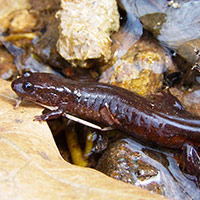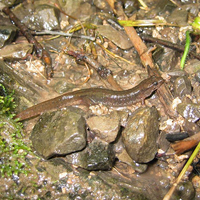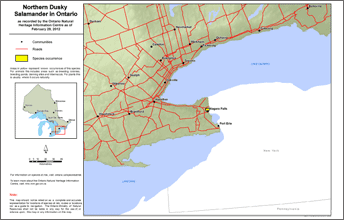Northern dusky salamander
Scientific name: Desmognathus fuscus


Cover photos credit: Rob Tervo
Status
Endangered
“Endangered” means the species lives in the wild in Ontario but is facing imminent extinction or extirpation.
Date added to the Species at Risk in Ontario List
The Northern dusky salamander was already assessed as endangered when the Endangered Species Act took effect in 2008.
What it looks like
The Northern dusky salamander is usually gray to yellowish brown or dark brown and can reach about 6 to 14 cm in length.
Adults have hind legs that are much larger than the front legs and have a light bar that extends from the eye to the corner of the mouth.
Dark flecks may be found on the back and sides, and a ridge along the top of the tail.
Where it lives
Northern dusky salamander adults are mainly found on land, but are always close to small groundwater fed streams, seeps (areas where water in the ground oozes to the surface to form a pool) and springs, where they live under rocks, logs or leaf litter within or near water.
Where it’s been found in Ontario
The Northern dusky salamander is widely distributed in eastern North America, including Quebec and New Brunswick. In Ontario, it is restricted to a small area of the Niagara Peninsula.
View a Larger version of this map (PDF)
What threatens it
The Niagara area of Ontario has undergone significant development since European settlement, resulting in a loss of high quality groundwater habitat.
Activities that affect the quality and quantity of groundwater can result in a loss of high quality habitat that is essential to the survival of the Northern dusky salamander.
In addition, uncontrolled stormwater runoff has caused slope instabilities in adjacent areas, leaving these salamanders vulnerable to rock falls and mudslides.
Excessive trampling of seeps is also a threat to this species and their habitat.
Action we are taking
Endangered Species and their general habitat are automatically protected.
Recovery strategy
A recovery strategy advises the ministry on ways to ensure healthy numbers of the species return to Ontario.
Read the executive summary (January 11, 2013)
Read the recovery strategy (January 11, 2013)
Government response statement
A government response statement outlines the actions the government intends to take or support to help recover the species.
Read the government response statement (October 11, 2013).
Five-year review of progress
A five-year review of progress made toward protecting and recovering a species is required no later than five years after the government response statement for that species is published.
Read the report on progress towards the protection and recovery of 17 species at risk, including the Allegheny Mountain Dusky Salamander and Northern Dusky Salamander (2018).
Habitat protection
General habitat descriptions are technical, science-based documents that provide greater clarity on the area of habitat protected for a species.
General Habitat Protection - June 30, 2008
What you can do
Report a sighting
- Report a sighting of an endangered animal or plant to the Natural Heritage Information Centre. Photographs with specific locations or mapping coordinates are always helpful.
Volunteer
Volunteer with your local nature club or provincial park to participate in surveys or stewardship work focused on species at risk.
Be a good steward
- private land owners have a very important role to play in species recovery; if you find a nesting on your land, you may be eligible for stewardship programs that support the protection and recovery of species at risk and their habitats
- visit the Ontario reptile and Amphibian Atlas: www.ontarionature.org/atlas to learn to learn more about Ontario’s rare amphibians, their habitat and related conservation initiatives
- as with all wildlife, be respectful and observe from a distance; please do not try to catch wild salamanders; bug repellent and oils on human hands may damage the delicate skin of these amphibians
- never buy salamanders that have been caught in the wild and never buy a native species of any kind that’s being sold as a pet
Report illegal activity
Report any illegal activity related to plants and wildlife to
Quick facts
- Northern dusky salamanders were once thought to be absent from Ontario, despite many historical reports, but were recently rediscovered in 1989
- Northern dusky salamanders overwinter below the frost line in seeps and underground retreats where the ground temperature is fairly constant
- mating and egg-laying takes place in the summer, and the females typically lay eggs in moist areas near the water such as under stones or logs and in moss
- when seized by a predator, the Northern dusky salamander has the ability to self-amputate its tail which continues to twitch, acting as an excellent diversion while the salamander escapes; a new tail soon replaces the old one
